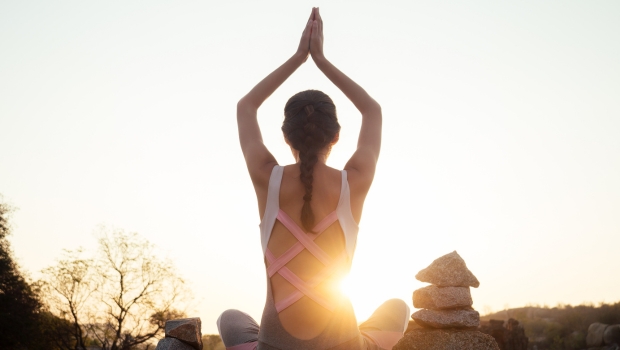Yoga and mindfulness complement each other, enhancing focus and presence. Certain yoga poses and sequences promote mindfulness by encouraging deep breathing and body awareness.
By intertwining these practices, individuals can cultivate a heightened sense of self-awareness and inner peace. The connection between yoga and mindfulness goes beyond physical postures, delving into the realms of mental clarity and emotional balance. Through intentional movement and breathwork, yogis can tap into a state of mindfulness that transcends the mat, positively impacting their daily lives.
Let’s explore how the fusion of yoga and mindfulness creates a powerful synergy that nurtures the mind, body, and spirit.
The Essence Of Yoga And Mindfulness
Yoga and mindfulness are two practices deeply rooted in ancient traditions, each with its own unique benefits for the mind, body, and spirit. When combined, they form a synergistic partnership that enhances self-awareness, inner peace, and overall well-being. The essence of yoga and mindfulness lies in their ability to cultivate a deep sense of presence and connection to the present moment, fostering a profound understanding of the self and the world around us.
Roots In Ancient Traditions
Yoga has its origins in ancient India, dating back thousands of years, and encompasses a holistic approach to physical, mental, and spiritual well-being. Mindfulness, derived from Buddhist meditation practices, focuses on non-judgmental awareness of the present moment. Together, they offer a harmonious blend of movement, breath, and mindfulness, creating a pathway to inner peace and self-discovery.
Modern Adaptations And Practices
In today’s fast-paced world, the integration of yoga and mindfulness has evolved to meet the needs of modern lifestyles. From yoga classes that incorporate mindfulness techniques to mindfulness-based stress reduction programs, the synergy between the two practices continues to flourish. This modern adaptation allows individuals to access the profound benefits of both disciplines, promoting emotional resilience, mental clarity, and a deep sense of inner balance.
Physical Benefits Of Yoga
Enhance mindfulness and reap the physical benefits of yoga with synergistic yoga poses and sequences. Discover the connection between yoga and mindfulness for a holistic approach to wellness.
Enhanced Flexibility And Strength
Yoga is a physical practice that has numerous benefits for the body. One of the most obvious physical benefits of yoga is that it enhances flexibility and strength. Yoga poses involve stretching and strengthening the muscles, which can lead to increased range of motion and improved muscle tone.Regular practice of yoga can improve flexibility in the hips, hamstrings, and shoulders, which are often tight and restricted due to our sedentary lifestyle. Increased flexibility can help prevent injuries and reduce the risk of developing chronic pain.Yoga also helps to build strength in the muscles, particularly in the core, arms, and legs. Many yoga poses require holding the body in challenging positions, which strengthens the muscles and improves overall body strength. This can help improve posture and balance, as well as prevent falls and injuries.Improved Posture And Balance
Another physical benefit of yoga is improved posture and balance. Poor posture can lead to chronic pain and discomfort, particularly in the neck, shoulders, and back. Yoga helps to improve posture by strengthening the muscles that support the spine and promoting proper alignment of the body.Yoga also helps to improve balance, which is important for preventing falls and injuries. Many yoga poses require standing on one leg or maintaining balance in challenging positions, which can help improve overall balance and stability.In summary, yoga is a powerful practice that offers numerous physical benefits, including enhanced flexibility and strength, improved posture and balance. Incorporating yoga into your daily routine can help you to feel better physically and mentally, and lead to a healthier, more balanced life.Mental Clarity Through Mindfulness
Enhance mental clarity through the synergistic practice of yoga and mindfulness. By exploring the connection between the two, individuals can improve their mindfulness through specific yoga poses and sequences. This combination provides a powerful tool for achieving inner peace and focus.
In today’s fast-paced world, finding mental clarity can be a challenge. Our minds are constantly bombarded with distractions, stress, and information overload. This is where mindfulness comes into play. By practicing mindfulness, we can cultivate a state of mental clarity and focus that allows us to navigate through life with ease.Stress Reduction Techniques
Stress is a common part of our daily lives, but it doesn’t have to consume us. Mindfulness offers effective techniques for reducing stress and promoting overall well-being. By bringing our attention to the present moment through breathing exercises and gentle yoga movements, we can release tension and bring a sense of calm to our minds and bodies.Cultivating Focus And Concentration
In a world filled with distractions, cultivating focus and concentration is essential. Mindfulness practices, such as focused breathing and meditation, help train our minds to stay present and focused on the task at hand. By incorporating yoga poses that require balance and concentration, we can further enhance our ability to stay focused and cultivate mental clarity.Yoga Poses And Sequences That Enhance Mindfulness
Certain yoga poses and sequences have been specifically designed to enhance mindfulness. These poses often require us to pay close attention to our breath, body alignment, and sensations. By practicing these poses regularly, we can deepen our connection to the present moment and develop a heightened sense of awareness.Here are a few yoga poses and sequences that can enhance mindfulness:– Mountain Pose (Tadasana): This simple standing pose allows us to ground ourselves and bring awareness to our body alignment and breath. – Sun Salutations (Surya Namaskar): This flowing sequence of poses synchronizes breath with movement, promoting a meditative state of mind. – Warrior II (Virabhadrasana II): This pose strengthens the legs and cultivates focus as we gaze over our front fingertips. – Tree Pose (Vrikshasana): This balancing pose requires concentration and stability, helping to bring our attention fully into the present moment.By incorporating these yoga poses and sequences into our practice, we can enhance our mindfulness and experience the benefits of mental clarity, reduced stress, and improved focus and concentration. So, take a moment to breathe, step onto your mat, and embark on a journey of synergy between yoga and mindfulness.Emotional Equilibrium With Yoga
Explore the powerful connection between yoga and mindfulness, and how they work together to cultivate emotional equilibrium. Discover specific yoga poses and sequences that enhance mindfulness, offering a synergistic practice for finding balance and peace of mind.
Navigating Emotional Turbulence
The Power of Yoga in Balancing Emotions
Yoga is not just a physical exercise; it is a holistic practice that encompasses the mind, body, and spirit. When it comes to emotional equilibrium, yoga can be a powerful tool to navigate the turbulence within. Through mindful movement, deep breathing, and focused attention, yoga helps us tap into our inner emotional landscape and find balance amidst the storm. By practicing yoga, we can cultivate self-awareness, regulate our emotions, and develop a greater sense of emotional resilience.The Role of Mindfulness in Emotion Regulation
Mindfulness, a key component of yoga, involves paying attention to the present moment without judgment. It allows us to observe our thoughts, feelings, and bodily sensations with curiosity and acceptance. By bringing mindfulness into our yoga practice, we can enhance our ability to regulate emotions. When we become aware of our emotions, we can choose how to respond to them rather than reacting impulsively. Mindfulness enables us to pause, acknowledge our emotions, and make conscious choices that align with our values and well-being.Fostering Positive Mindsets
The Influence of Yoga on Positive Thinking
Yoga has a profound impact on our mental state, including our thoughts and beliefs. Through yoga practice, we can cultivate positive mindsets that promote emotional well-being. By focusing on our breath, body sensations, and movements, we can quiet the chatter of the mind and cultivate a more positive outlook. Yoga helps us develop a deep sense of gratitude, self-compassion, and acceptance, which are essential for fostering a positive mindset.The Integration of Mindfulness in Positive Psychology
Mindfulness and positive psychology go hand in hand when it comes to cultivating positive mindsets. Positive psychology emphasizes the importance of focusing on strengths, cultivating gratitude, and nurturing positive emotions. By integrating mindfulness into positive psychology, we can enhance our ability to savor positive experiences, shift our attention to the present moment, and reframe negative thoughts. This integration allows us to foster positive mindsets that support emotional equilibrium and overall well-being.In conclusion, the practice of yoga and mindfulness can greatly contribute to emotional equilibrium. By navigating emotional turbulence through yoga and harnessing the power of mindfulness, we can develop self-awareness, regulate our emotions, foster positive mindsets, and ultimately cultivate a greater sense of emotional balance in our lives. So, let’s roll out our yoga mats and embark on this synergistic journey of yoga and mindfulness.Breathing: The Bridge Between Body And Mind
When it comes to the connection between yoga and mindfulness, one of the most fundamental aspects is the role of breathing. The breath serves as the bridge that connects the body and the mind, facilitating a deeper awareness of the present moment and promoting a sense of calm and centeredness.
Pranayama – The Art Of Breath Control
Pranayama, often referred to as the art of breath control, is a foundational practice in yoga that focuses on regulating the breath to enhance overall well-being. By engaging in specific breathing techniques, individuals can influence their mental and emotional states, promoting a sense of clarity and tranquility.
Breath Awareness For Mindfulness
Developing breath awareness is a key component of mindfulness practice. By directing attention to the breath, individuals can cultivate a heightened sense of presence and focus. This deliberate focus on the breath serves as an anchor, grounding practitioners in the current moment and fostering a deeper connection between the body and the mind.
The Science Behind Yoga And Mindfulness
The Science Behind Yoga and Mindfulness:
Yoga and mindfulness are interconnected practices that bring numerous benefits to physical and mental well-being. Understanding the science behind these practices sheds light on how they work synergistically to promote overall health.
Neurological Benefits
- Yoga and mindfulness positively impact brain function.
- Mindfulness practices help reduce stress and anxiety.
- Yoga poses improve cognitive function and memory.
The Impact On The Immune System
- Yoga and mindfulness boost immune response.
- Mindfulness reduces inflammation in the body.
- Yoga sequences enhance overall immune system function.
Incorporating Yoga And Mindfulness Into Daily Life
Integrating yoga and mindfulness into your daily routine can enhance well-being and mental clarity.
Simple Routines For Busy Schedules
Start your day with a short yoga flow or meditation session to set a positive tone.
- Practice deep breathing exercises during work breaks.
- Take mindful walks in nature to rejuvenate your mind.
Creating A Personalized Practice
Customize your yoga routine with poses that resonate with you:
- Include forward bends to promote introspection.
- Try tree pose for balance and focus.
Overcoming Common Challenges
Discover the powerful synergy between yoga and mindfulness, and how they can help overcome common challenges. Explore the connection and learn about yoga poses and sequences that enhance mindfulness, promoting a balanced and peaceful state of mind.
Dealing With Distractions
When practicing mindfulness during yoga, acknowledge distractions without judgment.
Focus on breathing and sensations to bring your mind back.
Use mantras or visualizations to maintain attention during practice.
Building Consistency And Discipline
Create a regular schedule for yoga and mindfulness practice.
Set small achievable goals to stay motivated.
Join a community or find an accountability partner for support.
Community And Collective Practice
Practicing yoga and mindfulness in a community setting fosters a sense of belonging and support.
Connecting with others enhances our individual practice and deepens our mindfulness experience.
Shared energy in group sessions elevates the practice and strengthens collective mindfulness.
The Role Of Yoga Studios And Retreats
Yoga studios and retreats provide physical spaces for group practice and community building.
Expert guidance in studios and retreats enhances the mindfulness journey for all participants.
Online Platforms And Virtual Classes
Virtual classes offer flexibility for remote practice and connectivity with a global community.
Accessible resources online make mindfulness and yoga more inclusive and widespread.

Credit: naturalawakeningsnnj.com
Beyond The Mat: Yoga Philosophy And Lifestyle
Yoga is more than just physical postures and breathing exercises; it encompasses a comprehensive philosophy and way of life. Beyond the mat, the principles of yoga extend into various aspects of daily living, guiding practitioners to cultivate mindfulness and ethical behavior in their interactions and endeavors.
Ethical Precepts Of Yoga
The ethical precepts of yoga, known as the Yamas and Niyamas, provide a framework for moral and ethical conduct, offering guidance on how to interact with oneself and others in a mindful and compassionate manner. These principles include non-violence, truthfulness, non-stealing, moderation, and contentment, among others.
Integrating Mindfulness In Relationships And Work
Integrating mindfulness into relationships and work involves applying the principles of yoga to enhance communication, foster empathy, and promote harmony. By cultivating awareness and compassion, individuals can navigate interpersonal dynamics and professional environments with greater equanimity and understanding.
Measuring Progress And Success
Measuring progress and success in a synergistic practice of yoga and mindfulness involves exploring their connection. Certain yoga poses and sequences can enhance mindfulness, allowing practitioners to experience deeper relaxation and self-awareness. By regularly incorporating mindfulness into their yoga practice, individuals can track their progress and achieve a greater sense of overall success in their mental and physical wellbeing.
When practicing yoga and mindfulness, it’s important to have a way to measure your progress and success. By setting personal milestones and recognizing your growth, you can track your journey towards achieving greater mindfulness. Remember, the journey itself is the reward.Frequently Asked Questions
What Is The Relationship Between Yoga And Mindfulness?
The practice of yoga enhances mindfulness by promoting awareness of the body, breath, and present moment. Mindfulness meditation, a key aspect of yoga, cultivates focused attention and self-compassion, deepening the mind-body connection.
How Do Yoga Poses Enhance Mindfulness?
Yoga poses, or asanas, promote mindfulness by encouraging practitioners to be fully present in the posture, focus on the breath, and observe physical sensations without judgment. This cultivates a state of mindfulness that extends beyond the mat into daily life.
Can Beginners Benefit From Combining Yoga And Mindfulness?
Absolutely. Integrating yoga and mindfulness can be especially beneficial for beginners, as the practice offers a holistic approach to physical, mental, and emotional well-being. It provides a gentle introduction to mindfulness through movement, breath awareness, and relaxation techniques.
What Are Some Yoga Sequences That Promote Mindfulness?
Sequences such as Sun Salutations, Warrior series, and Gentle Flow encourage mindfulness by linking breath with movement, fostering a meditative state. These fluid, intentional sequences help practitioners develop a deeper sense of awareness and presence in the practice.
Conclusion
Yoga and mindfulness are two practices that complement each other perfectly. By incorporating mindfulness into yoga, one can enhance their overall experience and achieve a greater sense of self-awareness. From simple poses like Savasana to more complex sequences like Sun Salutation, there are various ways to integrate mindfulness into a yoga practice.
By embracing this synergistic practice, individuals can improve their physical, mental, and emotional well-being. So, let’s start exploring the connection between yoga and mindfulness to lead a more fulfilling life.



